Canning peaches yourself at home is easy. It really is! Or at least, that’s what all the recipes tell you. When I tried it recently, I made more than my fair share mistakes.
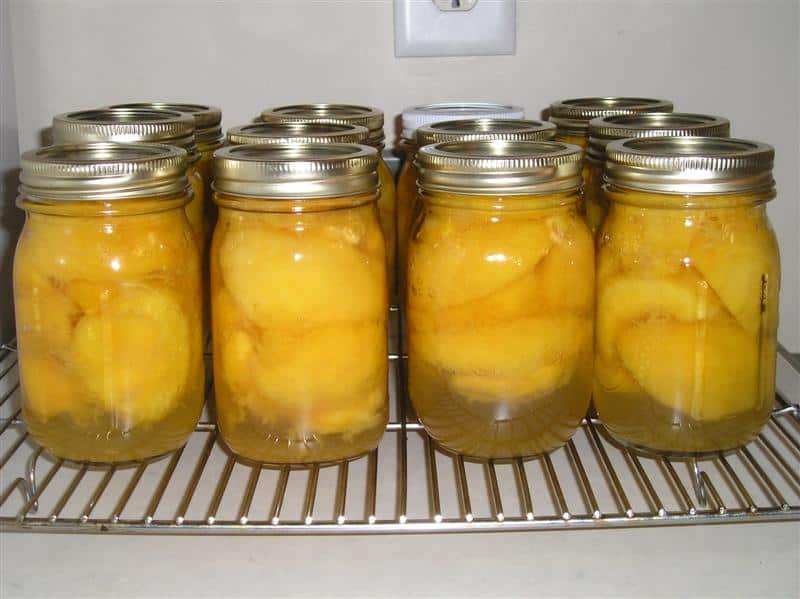
But, now that I know better I’m going to share with you the recipe that worked for me, and also tell you where I went wrong so you can avoid the same snags that I did.
Canned peaches are absolutely delicious, versatile and long-lasting and once you’ve had ones that you canned yourself at home you’ll never want to go back to the grocery store tin can kind. Keep reading and I’ll tell you everything you need to do a good job and how to do it.
Things You’ll Need
Peaches: You’ve got to have peaches to get canned peaches, right? Just make sure you get perfect, unblemished and ripe ones!
A peach is just right for canning when you can press on the skin with your thumb, and it leaves a dent. If the peach is rock hard, supposedly putting it in a paper bag with a banana will help speed up the ripening. Either way, just give it a couple of days to get good and ready.
Do NOT try canning unripe peaches. You’ll wish you’d never been born.
Canning peaches yourself at home is easy. It really is! Or at least, that’s what all the recipes tell you. When I tried it recently, I made more than my fair share mistakes.
But, now that I know better I’m going to share with you the recipe that worked for me, and also tell you where I went wrong so you can avoid the same snags that I did.
Canned peaches are absolutely delicious, versatile and long-lasting and once you’ve had ones that you canned yourself at home you’ll never want to go back to the grocery store tin can kind. Keep reading and I’ll tell you everything you need to do a good job and how to do it.
Water: you need water for washing and blanching the peaches, making syrup, operating the canner and sterilizing your jars and lids.
Ice: ice is needed to chill the water in order to blanch the peaches properly and get those skins off easily.
Sugar: sugar is a necessary ingredient for making the simple syrup that you’ll cover the peach pieces with. Note that you can can your peaches with water only, but they won’t be nearly as good.
Lemon Juice: you can dunk peach pieces and lemon juice to keep them from turning brown after canning. You don’t have to do this, as they’ll still taste the same, but this makes them look much nicer when sitting in neat rows on the shelf!
Salt (Optional): if you don’t want to use lemon juice, you can combine salt with vinegar, next on our list to prevent the peach pieces from browning.
Vinegar (Optional): as mentioned above, vinegar can be used with salt to create an anti-browning solution for your peach pieces. You don’t need either if you are using lemon juice.
Canner: peaches are properly canned using a water bath canner or a steam canner. I use a steam canner, myself.
Large Pot: for boiling your peaches, a large pot will give you plenty of room to work without risk of overflows.
Small Pot: a smaller pot can hold the water and sugar to make your syrup.
Large Bowl: an extra large bowl for holding an ice water bath, needed to blanch your peaches and stop the cooking process after boiling them.
Spoon: a common, large kitchen spoon. You can use wood, metal, or plastic. It doesn’t matter.
Canning Jars: pint or quart jars at your preference. Either is just fine for peaches, and will only slightly impact your processing time.
Jar Lids: you’ll need brand new lids for your canning jars assuming you don’t have ones with reusable lids. Never, ever try to reuse a canning jar lid because they are just too prone to failure!
Jar Bands: jar bands that are appropriately sized for your jars. Unlike the lids, bands are reusable as long as they are in good shape. And that means no rust, dents, cracks or anything like that.
Jar Tongs: jar tongs, or jar lifters, are indispensable for lifting and maneuvering hot, heavy jars.
Lid Wand: a magnetic lid wand is my favorite canning tool. It makes grabbing a piping hot lid out of its simmering water bath easy and safe.
Paper Towels: paper towels come in handy for cleaning up spills and also for wiping off the rims of your jars after you pack them. Dirty rims make lids more likely to fail, and that means ruined peaches!
Cutting Board: just a cutting board. As long as it’s clean you can use whichever kind you like best.
Paring Knife: a pair of knife is all you need to slice and portion your peaches. You can use a larger kitchen knife if you’re more comfortable with it.
Peeler (Optional): sometimes, despite your best efforts, the skins of your peaches just won’t come off after you blanch them. Have a backup plan in the form of a peeler unless you are handy with a knife. A fruit peeler or a potato peeler works best.
Canning Your Own Peaches at Home, Step by Step
Okay, so now that we’ve got that squared away, let’s get on with the fun. Let me show you how to can peaches!
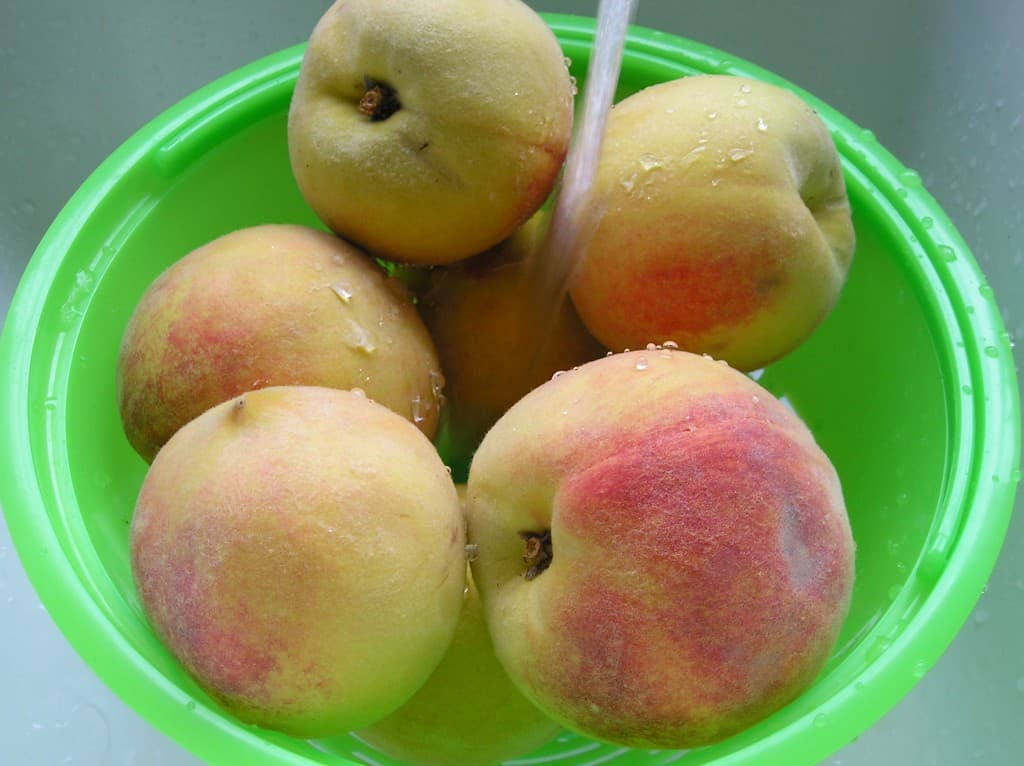
Step 1: Wash peaches, prepare canning supplies.
First thing’s first. You’ll need to wash the peaches.
You also want to make sure to have some clean jars, hot and ready. I put mine in the dishwasher to sanitize and keep hot until I’m ready for them. You can also put them into a large pot of boiling hot water until it’s time to fill them.
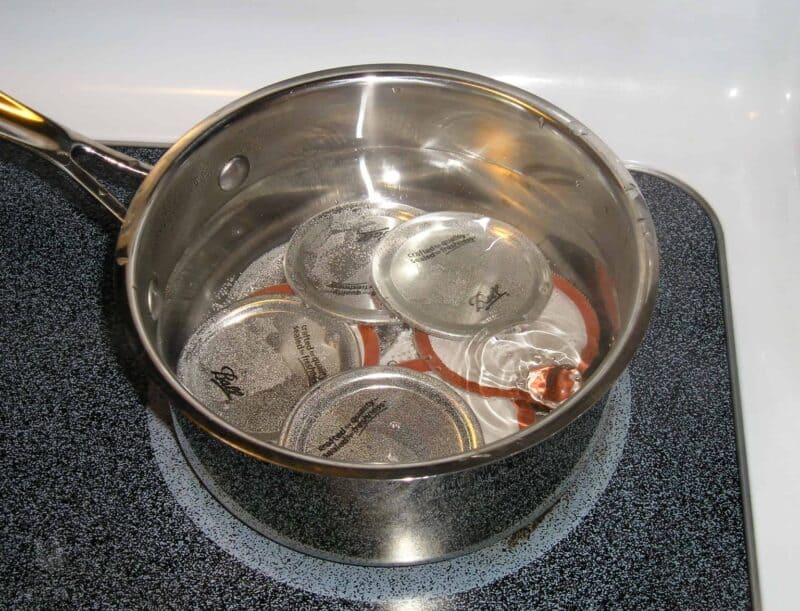
Make sure you have clean lids and rings ready to go as well. Get a small pot of simmering water going to sanitize your lids (be sure not to let them boil).
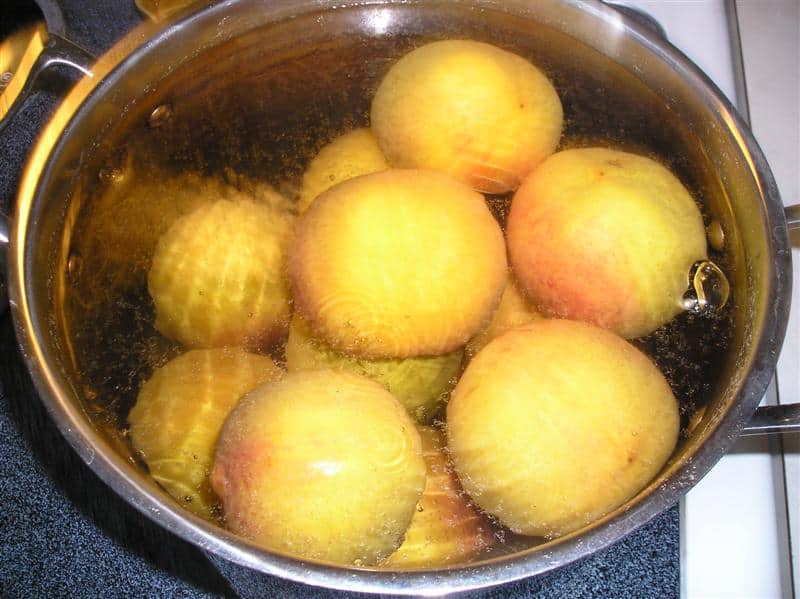
Step 2: Boil peaches:
Next, you’ll want to blanch the peaches. This process makes peeling them a breeze (ripe ones, that is!) Get a big pot of boiling water going, and put 5 or 6 peaches at a time into the water. Don’t leave them long. They only need to be boiling for 30-60 seconds, max. They only need to be boiling for 30 to 60 seconds, max.
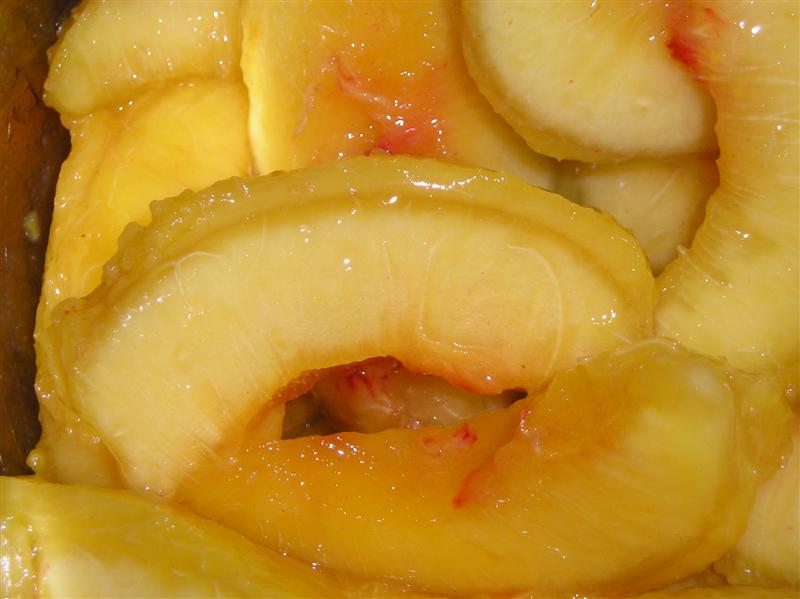
What actually ended up happening is that the peels still didn’t come off nicely. And then, since they’d been in the hot water so long, the peaches had begun cooking, so the outer layer of peach that is supposed to be firm and smooth, was mushy and slimy and, well, like the inside of a pumpkin. You can clearly see the layer of mushy skin on the peaches in the picture. It wasn’t pretty.
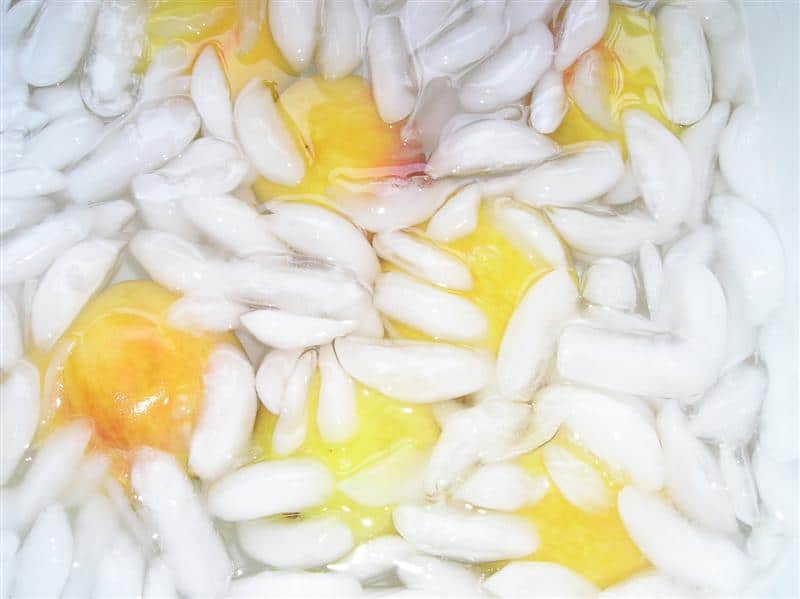
Step 3: Blanch.
After your peaches have been in the boiling water for no more than a minute, quickly plunge them into a large bowl or sink full of icy water for about two minutes. You’ll need a lot of ice for this.
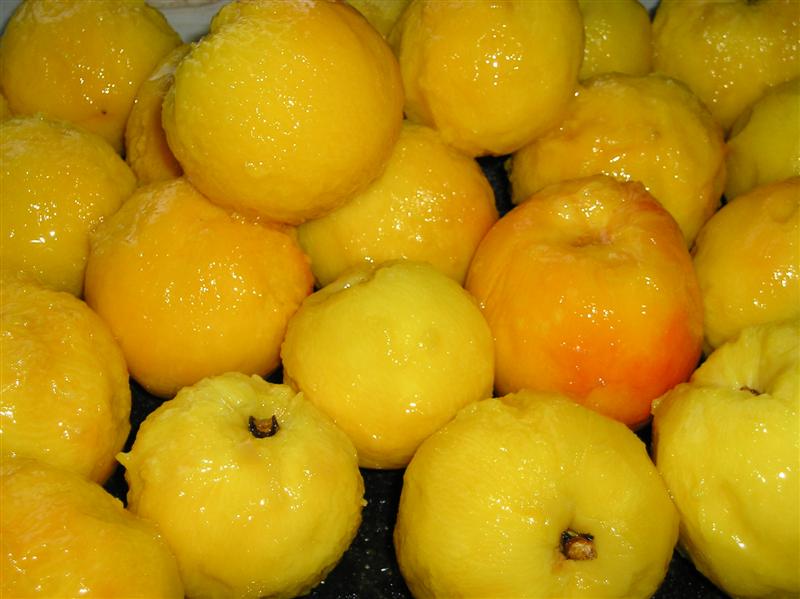
Step 4: Peel peaches.
Now they are ready to be peeled. If you are lucky, your peels will slip right off. If you are me, you’ll have to use a potato peeler to get most of them skin free.
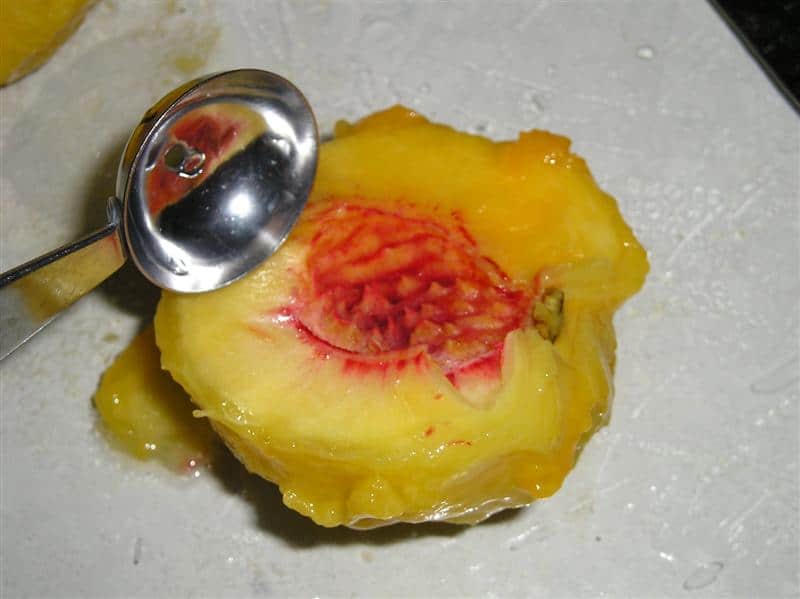
Step 5: Slice peaches, remove pits.
Next, cut the peaches in half, and remove the pits. I used a melon scooper to remove all of the gritty pink remains from the center of the peaches. I hate biting into that crunchy stuff!
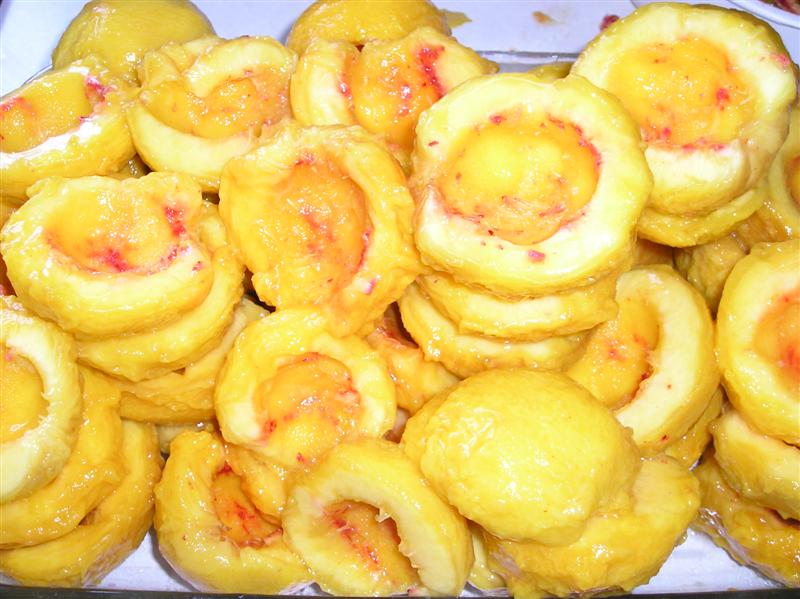
You can leave them as halves, like this, but I wanted to slice them up to save myself another step when I’m ready to serve them. It didn’t take me long, however, to decide I’d rather just leave them in halves at this point! I was so ready to be done.
Step 6: Dip peach pieces in acid.
It is suggested that you treat the peaches to keep them from turning brown. To do this, you can sprinkle them with lemon juice, tossing to coat. Or, you could drop the pieces into a gallon of water mixed with 2 Tbsp salt, and 2 Tbsp vinegar, to keep them looking good as you work.
I started to treat mine, but realized that they had sat so long already, it was pointless really. So, I did not treat most of my peaches. If they turn brown, it won’t affect the taste or quality. They just won’t look as nice.
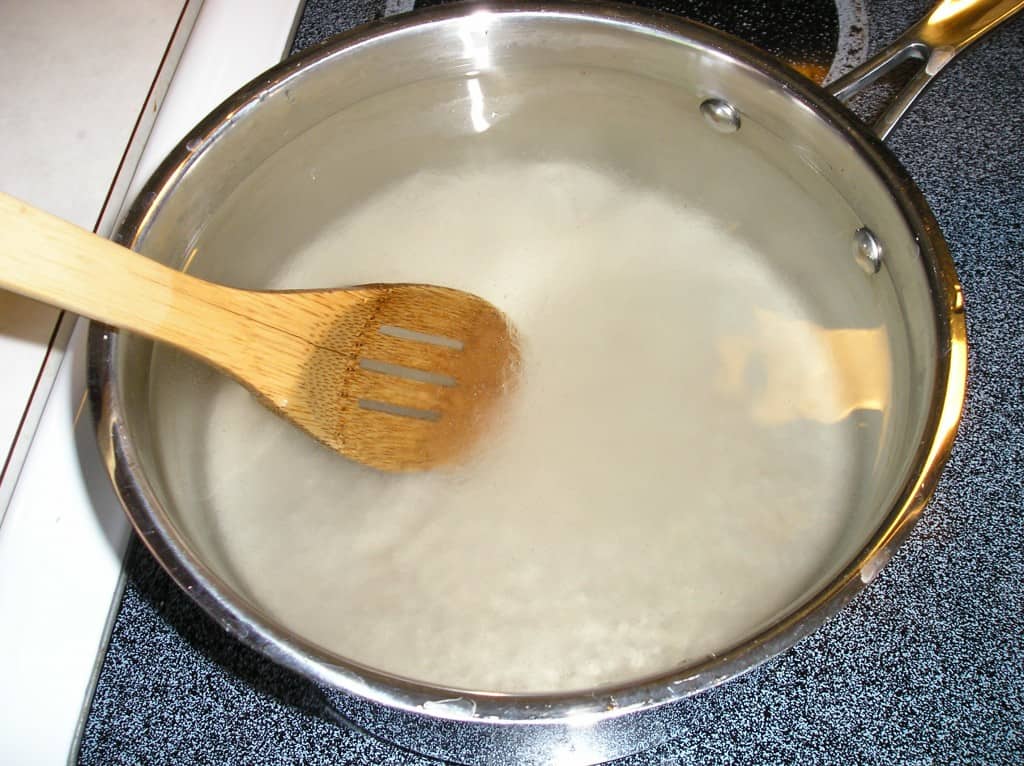
Step 7: Prepare syrup.
While slicing your peaches up, you should get a medium saucepan of syrup boiling. You can make a heavy, medium, or a light syrup. You can even just use straight water, though I thought it would be nice to have a little bit of sugar in with my peaches.
I opted for the light syrup recipe. Check the easy ratios below for your chosen kind. Bring the mixture to a boil for 2 minutes, stirring to completely dissolve the sugar, whichever one you go with..
- Light Syrup: 6 cups of water to 2 cups of sugar.
- Medium Syrup: 6 cups of water to 3 cups of sugar.
- Heavy Syrup: 6 cups of water to 4 cups of sugar.
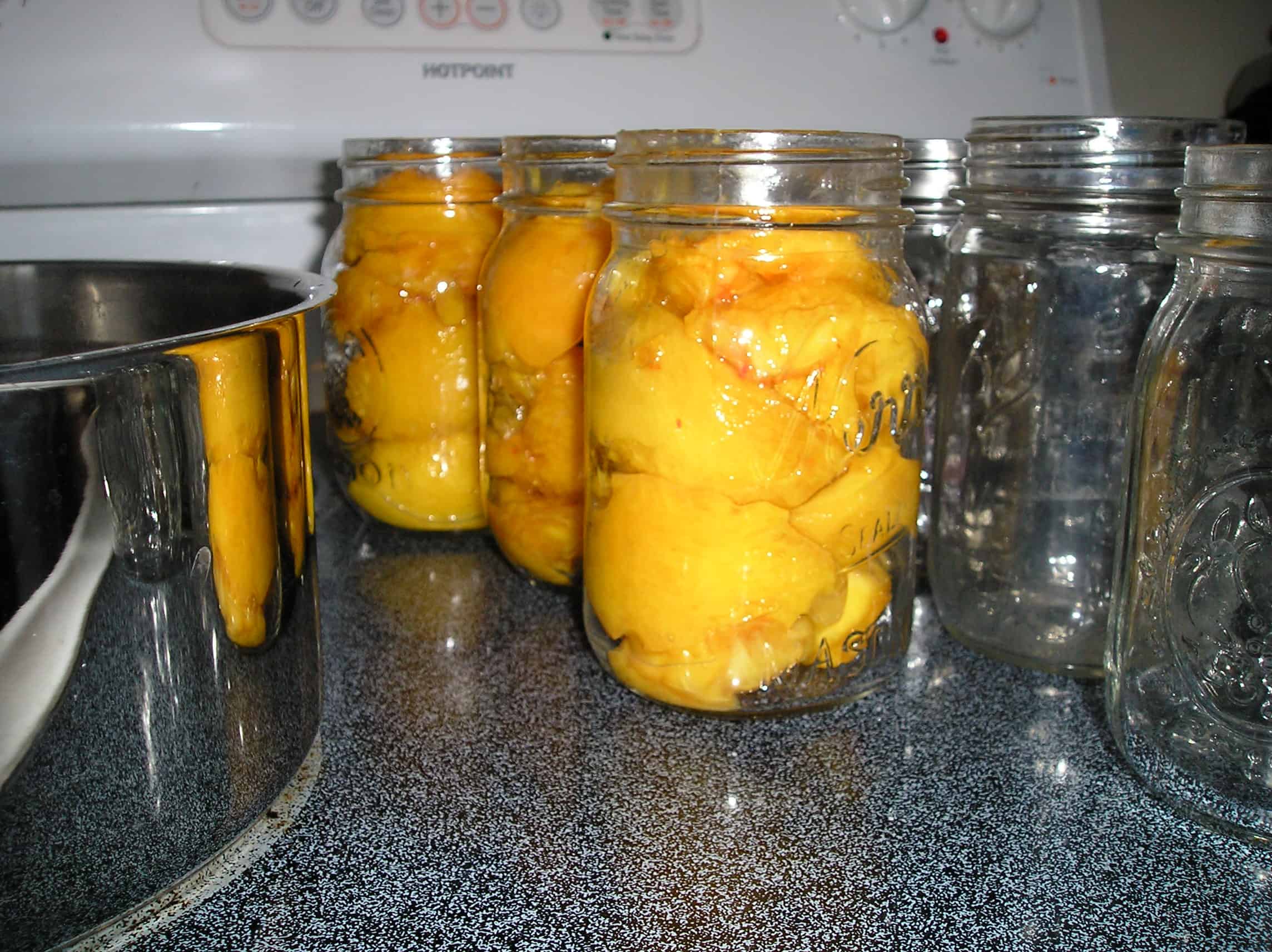
Step 8: Pack jars.
When your peaches are all sliced like you want them, pack them into the hot jars. Tap the jars on a towel laid over the countertop so that they pack down tight.
Fill the jars to within 1/2 inch from the top.
Step 9: Cover peaches with syrup and de-bubble.
Next, ladle the hot syrup into the jars. Fill to 1/2 inch from top:
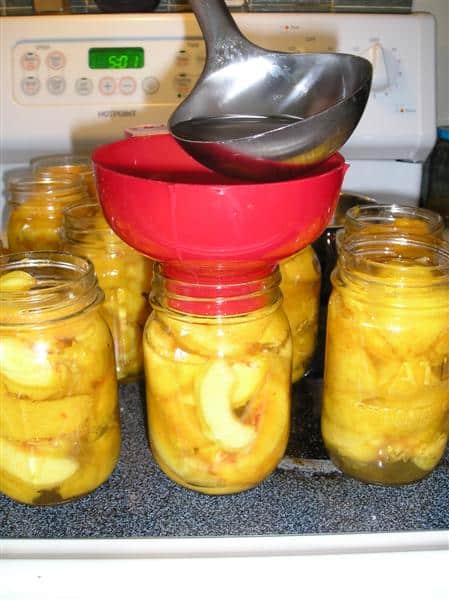
Use the end of a wooden spoon, or something, to remove any air bubbles. Tipping the jar slightly will help.
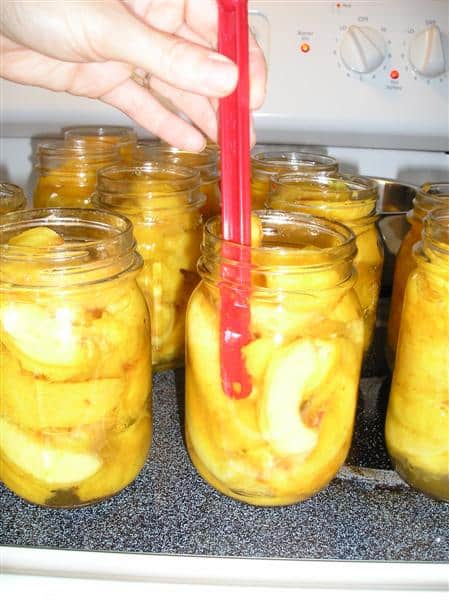
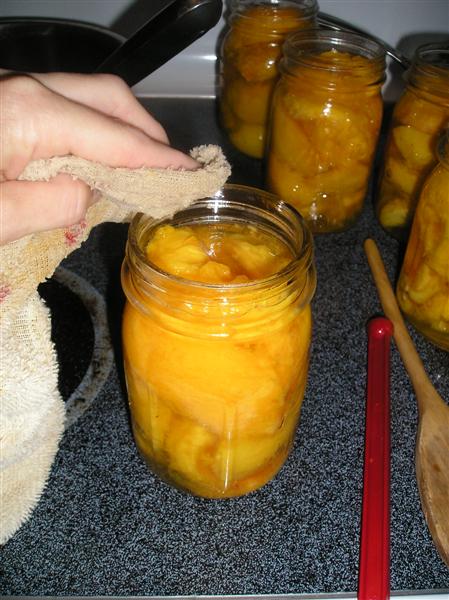
Step 10: Wipe off rim.
Wipe the rim of the jars with a clean, wet cloth to remove any stickiness. This is critical for getting a good seal with the lids; any residue can cause failure!
Retrieve a lid from the simmering pot of water (I love my magnetic lid lifter tool), and place it on the jar:
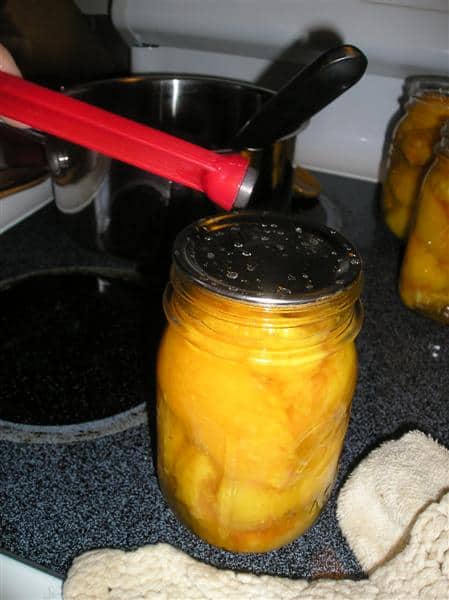
Screw the ring on hand tight only. Now you’re ready to put them into the canner:
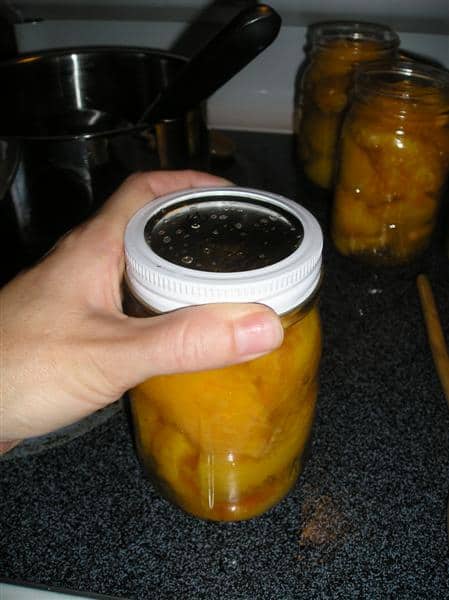
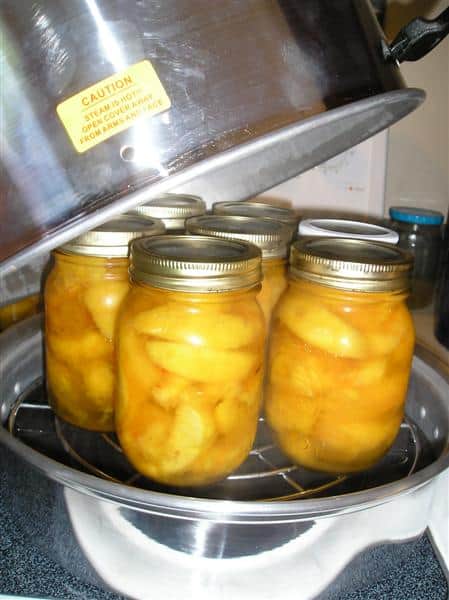
Step 12: Load canner.
Load the canner using your jar tongs or by placing all the jars on the rack (if yours is removable) and then loading it back inside.
Take great care to keep those jars upright and level the whole time! If they tilt, the contents could press against the lid, leak and cause a seal failure. It is easy to do, so be careful!
Step 13: Process.
You can water bath can peaches, or use a steam canner like I have here. Processing time is 20 minutes for pints, 25 minutes for quarts.
Step 14: Remove and cool.
Once the time is up, remove the jars from the canner and allow them to cool on a rack for 24 hours. Keep them protected from drafts, as a sudden temperature change, even from cool air, could shatter them!
Step 15: Check lids.
After that the cooling time is elapsed, remove the rings and make sure that the lids are secure. If you can easily pull a lid off, stick that jar in the fridge and eat those peaches soon. Alternately, you can reprocess them. See the section just after the step-by-step for more.

Step 16: Label and store. Write the date on the lids and place them in a cool, dry, dark place. Peaches have a shelf life of 12-18 months.
Step 17: All done! And that’s it! You’ve canned your own delicious peaches!
Re-Processing Jars that Failed
So, you have at least one jar of peaches that have a failed lid. What can you do?
Like I said above, if you want some peaches right now you can just pop them in the fridge and then eat them within a few days. They are still totally safe, there’s nothing wrong with them, they just aren’t going to last in storage the way you want them to.
Or, if you want, you can put a fresh lid on the jar and then run them through the canner again for the exact same amount of time using the process above to reprocess them. Assuming they pass your lid test, they’ll be ready to go into storage as normal.
However, the downside is that reprocessing them is basically going to cook them more, and that particular jar of peaches will have a lower overall quality level and the texture will be quite soft, maybe even a little slimy. But, they will be safe and you can store them with the others if you want to!
Where I Made a Mistake Canning Peaches
At one point, I really messed up, so it’s very important that I share this with you. I read on another blogger’s “How To” that if the peaches didn’t peel nicely after the first blanching, just put them back into the water for another 30-60 seconds and the peels will slip right off.
Well, not realizing at the time that my peaches were perhaps not ripe enough yet, and thinking that the problem was simply that I needed to blanch them longer, I decided to let all of my peaches boil for about 2 minutes before proceeding to the next step.
I know, *sigh*, I can hear all of you master canners gasping at me now. Yes, that’s right. I said it. I over blanched.
What actually ended up happening is that the peels still didn’t come off nicely.
And then, since they’d been in the hot water so long, the peaches had begun cooking, so the outer layer of peach that is supposed to be firm and smooth, was mushy and slimy and, well, like the inside of a pumpkin. You can clearly see the layer of mushy skin on the peaches in the picture. It wasn’t pretty.
Peaches Canning Tips
I have read another commenter who says that she never peels the peaches before canning. She maintains that once the jars have been hot water bathed, the skins will slip right off of the peaches as you remove them from the jar. Next time, I am definitely trying that!
I also found this tutorial over at Simple Bites to be very interesting. Her method seems so much easier than mine. She doesn’t use hot jars, just clean sanitized ones. And she doesn’t make a syrup.
Instead, she packs the peaches about 3/4 full into the jars, then adds about 1/3 cup sugar to each jar (though I’m not sure if this was for pints or quarts). Next, she fills the jars with lukewarm tapwater to within 1/2 inch from the top.
Have any other tips you can give us? Any of you can peaches using a different method?

A city girl learning to homestead on an acre of land in the country. Wife and homeschooling mother of four. Enjoying life, and everything that has to do with self sufficient living.

Help! This past summer, I froze beautiful fresh peaches(I used fruit fresh to keep from browning) to use in salsa later that fall.
My salsa is tomato based. I use canned tomatoes, but fresh cilantro, jalapeños, onions, and carrots. Sugar and salt to taste. In the past I always used canned peaches, but used fresh this time. I cooked the batches at low boil for at least 30 minutes and water bathed quarts for 20 minutes.
Everything looked and tasted great, but after opening a jar and refrigerating, a week later there was mold. Mostly on the pieces of peaches.
Do you know what I did wrong? Should I have cooked the peaches before adding them to the batch? You would think they would have cooked when boiled for 30 minutes.
Any light you can shed, I would appreciate. And should I toss the 20 qts now?😔
Thank you.
Oh my God I’m laughing out loud. I did the exact same thing bought a big box of peaches from the fruit stand they look beautiful never canned peaches before. Got everything ready got my kitchen ready set up put them in the boiling water for a few minutes take them out no the skins wouldn’t come off. I realize the dang things weren’t right three days later here I am now canning the right peaches and the skins come right off. But I did learn something from nasty not over Blanches because several of mine from yesterday came out just like the ones you showed in your photo thanks for the great post. Also I crushed up three 1000 mg vitamin C tablets to 1 gallon of water and let them soak to prevent discoloring work great and it was cheaper than some of the other alternatives.
Sorry about the typo I was using voice. What I meant to say is some of my peaches layover blanched. Strikes a nasty not sure where that came from lol
I am a long-time canner but still read my book on how to process. I was tired, it was late, and I was working on the peaches alone. Aside from over-blanching my peaches, my husband was working on pressure-canning potatoes at the same time. We were ready about the same time to process our respective elements. I just have to say, NEVER DO THIS. In an effort to keep his instructions straight since this was a first-time potato run for both of us, I was reading instructions at the same time and pressure-canned both the potatoes and the peaches. The peaches almost exploded and turned very dark in the jar. I am not sure if they are even usable. I know you can pressure-can peaches but not at the length and pressure that I did. 25 minutes at 10-12 was just a bit too long 🙁 If there is anyone out there who has experienced this mistake, please let me know. Looking at the peaches, I am considering opening all the jars and if they are tasty, I may make them into fruit leather.
I cut my peaches in half, pit them and then add boiling water. Remove after 45 seconds to a minute and the skins peel right off. You have a perfect half peach. Add to water with lemon juice until ready to put in jars. Water bath for 25 minutes. I also use medium syrup.
Ok I just tried canning some big huge peaches I bought at a fruit stand today. The box cost me 45.00 and I wish I would of gone with my gutt and either waited a few days or made them into jam. After reading this I can totally relate. I am laughing so hard right now my stomach hurts. My peaches ended up in pieces. I ended up with 6 jars of peach pieces. Yes I over blanched mine too and a great deal of them that were mushy!! I am in the process right now of waiting for the water bath canner so I can process my peach pieces. I thought this would be so easy after watching this lady last night on You Tube who did it perfectly!! I was so excited to try this and oh my what a peeling experience! I printed this off so I can try again and hopefully get some better results next time!
I bought peaches on Wed. Made peach jelly out of the peelings and it was late when I got though. So the peaches I cut up I put up in the fridge with water and lemon juice on them they are still a pretty color. My question is what do I need to do? Do I need to bring them to room temperature cook them til warm or what? I hate to waste them. I need help ASAP. Thank you so much. Cheryl
I processed peach preserves per instructions, however one batch sealed but the second batch did not. Can I reprocess the second batch and try again to get the lids to seal?
I canned peach preserves without sugar, just suregel and lemon juice. I cooked and mashed the peached for 10 minutes or so then sealed them in a hot water bath.
They are not thick enough though they look good and have a good color. Can I recook them and add some sugar and reprocess without killing my family?
Yes, you can. Especially if you do it right away. The heating up is the process that kills any micro-organisms that might spoil your preserves. The sealing keeps it safe. The tricky part is the sugar. For preserves you need the right sugar to pectin ratio. There is sugar and pectin in most fruits but getting consistent results works best when you follow the directions on the pectin package.
I know some one asked earlier but didnt see a answer. I canned peaches earlier this fall and now they are slightly turning brown on the tops. How do I know if they are safe to eat. This is only my 2nd time canning peaches and the first time they didnt last long enough to know if they would have turned brown also. I dont see any bubbling just turning light brown at tops of jars.
Always use fruit fresh with peaches. You can put it in the syrup or ice bath.
I also seem to have trouble with the fruit floating- no matter how tight I pack the quart jars- also when I remove the jars from the water bath and let them seal- the jars are sticky- the syrup from the jars leaks into the water bath while cooking. Is this normal ? I am checking head space, wiping down the jar rims, removing any air in the packed fruit- finger tight on the rings- any ideas or suggestions ??
It is completely normal to have some leaching from the jars. It happens when there wasn’t enough head space. Remove your rings and clean your jars before storage. If at least half the liquid is left in each jar after processing, your product is fine. Floating is also normal. Once the cool completely they will usually settle. After about 24 -48 hours it is okay to flip your jar to get them out of the head space. Hot fruit floats. 🙂
I used to do a lot of canning but haven’t done any for the past 30 years or so. Had some wonderful peaches this year so bought a 1/2 bushel and settled in to can them. They were ripe enough but for some reason, the skins seemed too thin and tore easily when I tried to remove them after the blanch/chill process so I ended up with the potato peeler. My peaches also floated after I took the jars out of the canner, but the jars were sealed tight so I have just turned them upside down occasionally to try to keep them from turning brown where they are above the syrup. They just were not pretty enough to give as gifts this year. I used the cold pack method, adding the hot syrup and sliding a flat table knife around the inside of the jar to get out trapped air bubbles before the hot water bath.
I put all my jars in the dishwasher and run it on the shortest, hottest cycle, then leave the jars in the dishwasher until I am ready to use them.
I love the idea of using the slow cooker to make the syrup. Will try that next year.
This is the first time I have canned peaches. We followed the directions as stated, using quarts. We packed the fruit. After processing the fruit is floating on the top half of the jar. Literally, the top half is fruit (looks like a pint).
I appreciate your help.
Thanks,
Dee
Hi Dee,
thats not unusual – even packing them in tight they will float. I tap the bottle on the counter kind of tipping it a little on each side and tapping – it helps pack them down without breaking them up.
Food preservation is a science. Please always follow the most up to date food safe practices found at the National Center for Home Food Preservation. And, consider taking a canning class or two at your county extension office. Your families safety is well worth it. Nobody wants botulism or any other food borne disease.
I canned peaches over the summer. Everything went fine…or so I thought. I noticed my peaches are turning brown from the top down. The jars are sealed and the peaches are covered in water… so I’m not sure where I went wrong.
I’ve had this same problem and cannot find any solution. No one I talk to has even heard of this problem.
I too have brown on top of my peaches and they look like something ugly is growing out of the tops. But the peaches below that look perfect. Are they considered compromised and totally full of botulism?
I am also a first timer at canning and I lost about 13 quart of my fruit in the pressure canner. I did learn that the water level in the pressure canner matter a lot. My pressure canner recommended that the water level should be about 2 to 3 inch. I did do just that but when I put my jars in the water the level of the water rise up to about half way up the jars. So at the end, I have 20 quart of peaches and nectarines canned.
Here is a question for you why is my fruits is mushy? I canned them in August and September and now is November and I when to open some of them to eat and the fruits did not hold up. It just fall a parts. There is no texture to its at all! What went wrong there?
Here is how I process my fruits;
I did the light sugar syrup and did the blanching and pitting but I did not peal my peaches or nectarines, because the fruits was not ripped yet and it was just like you exprince and I just give up on trying to peel it. I don’t minded the skin. When all of my jars are ready I put them in my All American pressure cooker/canner for 10minutes at 10 lbs weigh, cause where I’m at the elevation is at 2,566 feet.
Oh I did put all my fruits in the refrigerator due to that I am not sure what I’m doing yet. Basically I don’t truth myself!
Greatly appreciated any help to keep my fruit stay firm after canning! I will have to do it again next year and hope to have a better canned fruits.
Thanks you all
Selina,
First of all, I want to tell you that I think it’s fantastic that you are learning to can!! We all make mistakes in the beginning, so don’t let that discourage you.
Having said that, I’m not sure your fruit is ruined. I hope you haven’t tossed it all out! Why do you say you lost 13 quarts? Were they mushy, or did the jars just not seal?
It is normal for fruit to get soft after the canning process. You have essentially cooked it. It will not be firm as it was when it was fresh. I’m not sure how leaving the skins on the fruit will effect the product, but if the jars have sealed and the fruit tastes good (other than the softer texture), then they’re probably just fine. Make a cobbler with them and they’ll be delicious! It’s also normal for the water level to rise as you add the filled jars. You start with 2-3 inches of water in the canner, but by the time it’s filled the water will probably be close to the necks of the jars.
I hope that helped answer your question a little bit. 🙂 Keep up the great work!
Hi Selina,
Sorry to say but fruit isn’t cooked under pressure, in a pressure cooker. It is only cooked is a waterbath, boiling water or steam. I’m certain they are mush if you really did pressure cook them. I’d bet it would be really yummy syrup if it isn’t too late.
Actually the National Center for Home Food Preservation says you can process and she did just as the website says.
I bought canned peaches in a jar and when I opened them the seal was on the jar however the peaches were so soft they just fell apart, Why?
I’ve canned for 40 years. Fruit like peaches should only be water bath canned. A pressure cooker at 10 lbs would definitely just turn it into peach sauce, like applesauce. Get a Ball Blue book and follow instructions exactly. Tested, tried and true.
I would guess it’s because you used a pressure canner and not a hot water bath, as suggested. The pressure canned gets hotter, which means you likely cooked your peaches too much!
I’ve learned that’s lesson with a batch of dill pickles. They lost their crunch because of the heat in the pressure canner.
Here’s my tip for the syrup. I do this with all my fruit. I put the sugar in the jar, add the boiling water just before the fruit, swish the jar around to melt the sugar and done. Add the fruit and the water fills in as I add the fruit. No air pockets in your jar, no sugary, syrupy mess in your kitchen! Works for me, hope you’ll try it!
Your website came up on page one of google when I wanted to know why peaches were so slimy! I had a horrible ordeal yesterday. I bought 2 flats of peaches. I got my jars and lids sterilizing. I had another dutch oven pot boiling to blanch the peaches for the minute. I put the blanched peaches in cold water and began peeling and slicing (I hate cutting in half because I feel like I’m squishing the peach to oblivion…so I slice the whole peach until it falls apart easily to remove the stone). I had another pot stewing with water and sugar. Suddenly, my stove crapped out! I had no elements working and my peaches were starting to brown. I sprinkeled some lemon juice all over the peaches, then placed them in jars and then put these lidless jars in the fridge…praying for a miracle with my stove. Two hours later my stove was working again. I pulled out the cold jars and filled them up with simmering syrup. I put the lids on and screwed them up tight. I put them in boiling water to ‘can’ and, of course, two jars broke and the peaches seeped out everywhere.
It was a nightmare folks. My first time to can peaches and I had several jars of I don’t know what…are these peaches good? they were canned in boiling peach water and were sticky when I took them out of the canner 20 minutes later (I use 500 ml jars). The lids popped down, my indicator they were sealed tight. But are they?
So, I rinced off the sticky jars and put them in the fridge this morning. I tried a jar, and they were tasty. But will they last?
So today I did the routine all over again and now I have 8 jars of peaches that look great…but they are floating to the top. I didn’t get any air bubbles out because I didn’t know I had to.
*ahhhhhhhhhhhhhhhhhhhrunning out of the building in frustration
Cherylann,
I TOTALLY feel ya. And I’m sorry you had to go through such a frustrating ordeal. Unfortunately, any time you put hot liquid into a cold jar, or a cold jar into hot liquid, you can expect the glass to crack. (I learned the hard way, too.) I think it would be best to put the jars from that first batch in the fridge, just to be safe. Even though the lids sealed, the peaches may not have been heated adequately. As for the floating peaches, that’s totally normal.
Keep at it! And be proud of yourself for trying something new 🙂
Hi Kendra!
I just watched your presentation on how to use a steam canner. It was very well done. As an engineer who spent much of a long seagoing career working with high pressure (1000 psi+) steam, I would just warn you that you really do need to be very careful with that canner all the time. You’re far too pretty to be getting a steam burn!
It’s clear that your husband and family are lucky to have you. You write and act like a woman out of Proverbs 31, and there’s not much praise better than that. I’ve been pretty disgusted with a lot of the young people in our country. Watching you made me think there are at least some of you around who will have both the intelligence and the courage to pick up the pieces after the current “leaders” finish running us into the ditch. Thanks for trying to educate those who are willing to listen and may God bless you and your family at all times and in all places!
You have blessed me with your words today, Mac. Thank you so much for such a great compliment 🙂
Oh, my, what an ordeal so many of you are going through! LOL Please don’t be discouraged because of your experiences; you will be SO happy that you did the work when you pull out a jar of those beautiful fruits from your pantry for a pie or cobbler this winter. I’ve been canning, freezing and drying foods for 36 years. Although my feet and back ache from long hours in the kitchen, it is always worth it! I would strongly suggest that you get a good book on (updated) canning and follow the directions to the letter, including using hot jars and liquids, because cold food hitting hot water in your canner can result in broken jars! Not fun, after all the prep work! Also, if you have a friend or relative who can help you, it will cut your canning time in half – what a blessing!! Last, I keep a box of ascorbic acid on the counter as I cut up my peaches, and just sprinkle it on each layer, then toss the peaches (or whatever fruit I’m working up) around a bit to prevent discoloration. It only takes a few seconds, and is well worth it. Thanks for the suggestion of making syrup in the slow cooker – cooktop space is always at a premium on canning days!
I found this while doing a Google search for “canning peaches” and then looking at images so I could compare my first attempt to what’s normal…ha ha…I just LOVED your comments, especially about the “liars” LOL. That just made me feel so much better! I also “overblanched” because I had never done it before. I put the first 5 pound batch in the boiling pot, but then it stopped boiling. After 1 minute, I checked one peach and it was not peeling easy, so I kept them in there longer, only to discover the same mushy mess 🙁 I was so discouraged! I tried the next batch, but some of those were mushy too, so I guess I just put too many in at once and then removed them one at a time with a slotted spoon, which must be too slow. I figured I’d be lucky to get ANYTHING out of this ordeal. I already had the jars heating in the canner and the syrup going…so I had to keep trying. I also STRUGGLED trying to get half pieces and trying to get the pits out…talk about aggravating! It looked so easy on YouTube…ha ha. So I ended up slicing some and yes, taking out the yukky red parts too…I also hate those. Then since I knew I’d be slow, I soaked them in a solution of water/lemon juice until I had them all ready to put into the pint jars. They filled up fast, and I just could not get the half pieces to lie down the right way! (I was spooning them in over the funnel, but maybe I should’ve used a fork to place them with more control?!) Having no patience left, I just put them in the best I could and added the syrup. Of course I ran out of syrup and ended up with more jars than I thought I’d have…so I had to quickly make a little more syrup. I used honey syrup, so at least that was fast. Anyway, all said and done, even with some mushy mess that I saved in the fridge to eat later, I still got my 8 jars to fill the canner…BUT after processing, they did all float and I have WAY too much liquid at the bottom…and still some air bubbles, since I used the cold pack method (only because I didn’t really understand EXACTLY what to do for the hot pack method). Overall, a LOT of work for a LOT of frustration, but I am just learning. Maybe after I get to sample this batch, I’ll be motivated to try again. It helped finding your info and reader comments 🙂 You said to keep them in the cold water for just 2 minutes…I let mine sit in there while peeling, so I think they absorbed too much water and that was a mistake too. I hope I can get it all right next time! I’m going to look for the melon scooper…LOVE that idea!
Hi Pam,
Oh wow, what an ordeal! Sounds all too much like many of my own canning endeavors, lol!! Well, don’t give up. I’m proud of you for trying, and it definitely gets easier with experience!!! Great job getting 8 jars filled! I’m sure they’ll be delicious even if they aren’t perfect 🙂
I add 1/3 cup sugar and a little hot water in the bottom of each jar along with some fruit fresh. I stir this up and then begin adding the peeled and pitted peaches. When the jar starts getting full, I add a little more hot water to bring it up to the proper head space. This is a simple method and much easier (and less messy) than making hot syrup.
is that a 1/3 cup for a QUART size jar?
or pint?
Thank you so much for posting! I am going to attempt my first canning this yr. I am going to can several different foods, peaches being one of them. We shall see how it turns out. I come from a long family line of canners and the traditions have stopped. Time to start it up again! =) Happy canning!!
Hi Kendra
This reminds me of my first effort at canning peaches! In the end they were all fine & we enjoyed each bottle of them (even though they were also slightly cooked – oops). Thanks for sharing
Renata:)
I have unfond memories of my mother canning peaches. She would buy a bushel or 2 on the way home from visiting my granddparents. The next day she would need to can them. She would still be tired from the trip and she would be overwhelmed with fatigue and very irritable. The house would be hot and she would expect everyone to help her, but we didnn’t know what to do. Years later I canned them, too, but never enjoyed the experience. Perhaps my memories got in the way.
Thanks for sharing with us. We can learn from your challenges and it will be easier for your readers. I appreciate your generosity. Enjoy those yummy-looking peaches! daisy
Kendra your peaches are beautiful!!!
I got my last box of peaches canned last night and I am tired of looking or even eating peaches for a while 🙂 LOL I put up 19 quarts and 7 half pints plus 6 pints of peach butter a total of 2 bushels…I saved my peelings from last nights canning and I am going to try to make peach jelly ( thanks for one of your comments yesterday from Cathy ) One of my quart jars did not seal so I made a Peach pie with it and it was good…
Happy Canning!!!
Holly
Thank you so much for posting, I’ve been wanting to try canning peaches and now I’ll know what to look out for!
They look good!! I have just canned my first 1/2 bushel of peaches, too. Since it is around 100 degrees I opted to just use my potato peeler from the beginning so the stove wouldn’t heat the house up so much. I was surprised at how much my peaches shrank, there’s like an inch of syrup at the bottom. They’re still delicious! My total yield was 17 pints actually made it into the canner, the rest got eaten during processing 🙂 Of that I ate 1 pint with breakfast and the hubby used 3 to make a cobbler. They’re definitely going fast!
I canned peaches for the first time last year and it is quite the process. However, we loved them so much (I despise store bought canned peaches) I intend to make about 4 times more than I did last year. However, I did do enough of them to figure out how to move things along a little faster.
I blanch the peaches and then cut them in half. Remove the pit. At this time you can remove the pink part if it bothers you. Typically I can pull the skin off each half in almost, if not completely, one piece. Then I slice them and they are ready to go. If I find a stubborn half I slice it before it’s peeled and just run my pairing knife along the back side of the peach slice to remove the area of the skin that’s sticking.
This is quite a process and your peaches can be out for some time so I treat mine with fruit fresh. Once I get a decent layer I sprinkle a little and give them a toss and continue as I work. If you don’t treat them, they will brown later the longer they sit on the shelf. If you don’t mind, then you don’t mind, however, discoloration can be an indication that things are arye so you lose one of your indicators.
Also, I don’t recommend the second packing method of adding dry sugar and then water on top. I know plenty of people who don’t heat their peaches prior to canning them and they come out fine, so it’s a personal preference. However, I choose to hot pack mine. I add the syrup to the peaches just as it’s starting to boil and I let it sit on the peaches for several minutes while I put my last few pieces of my assembly line in order and make sure things are ready to go. This give the syrup long enough to ‘soak’ into the peaches without cooking them very much which would destroy some texture. However, I find this makes life much simpler because the heated syrup removes air that is naturally found in the fruit and helps prevent floating fruit.
Glad you made it out alive and I hope next year goes better!
Thanks for posting your first experience at canning peaches. I have been wanting to do this but hadn’t gotten around to it yet this summer. Your experience and pointers will surely help. Good job!
Ah yes, the unripe peaches. What a pain. I’ve had a few of those that I don’t realize until after attempting to peel/blanch. Ugh.
Only things I can add are awesome! About using a scoop for the pit goo. I’ve used a scoop for pear seed area removal, but never thought of that for peaches. I know what I’m doing with my nectarines this weekend… 😀
I never do the hot boiling jars, either. I water bath everything a minimum of 15 minutes, plus they’re all clean when I start anywho. Another neat trick I thought of the other day is making my syrup in the crockpot (a friend tells me this isn’t a new idea after googling it up after I mentioned it). It takes me a while to prep peaches (canning, alone, with four kids 6 and under underfoot is challenging to say the least). So it can take me a day to fill up 5 quarts. Having the hot syrup on hand and warm all day makes it easier – once I have a jar filled I dump in the syrup and it hangs out on the counter until I have a full canner load. I have almost 40qts hanging out on my counter from festivities the last several days, and I’m only getting started.